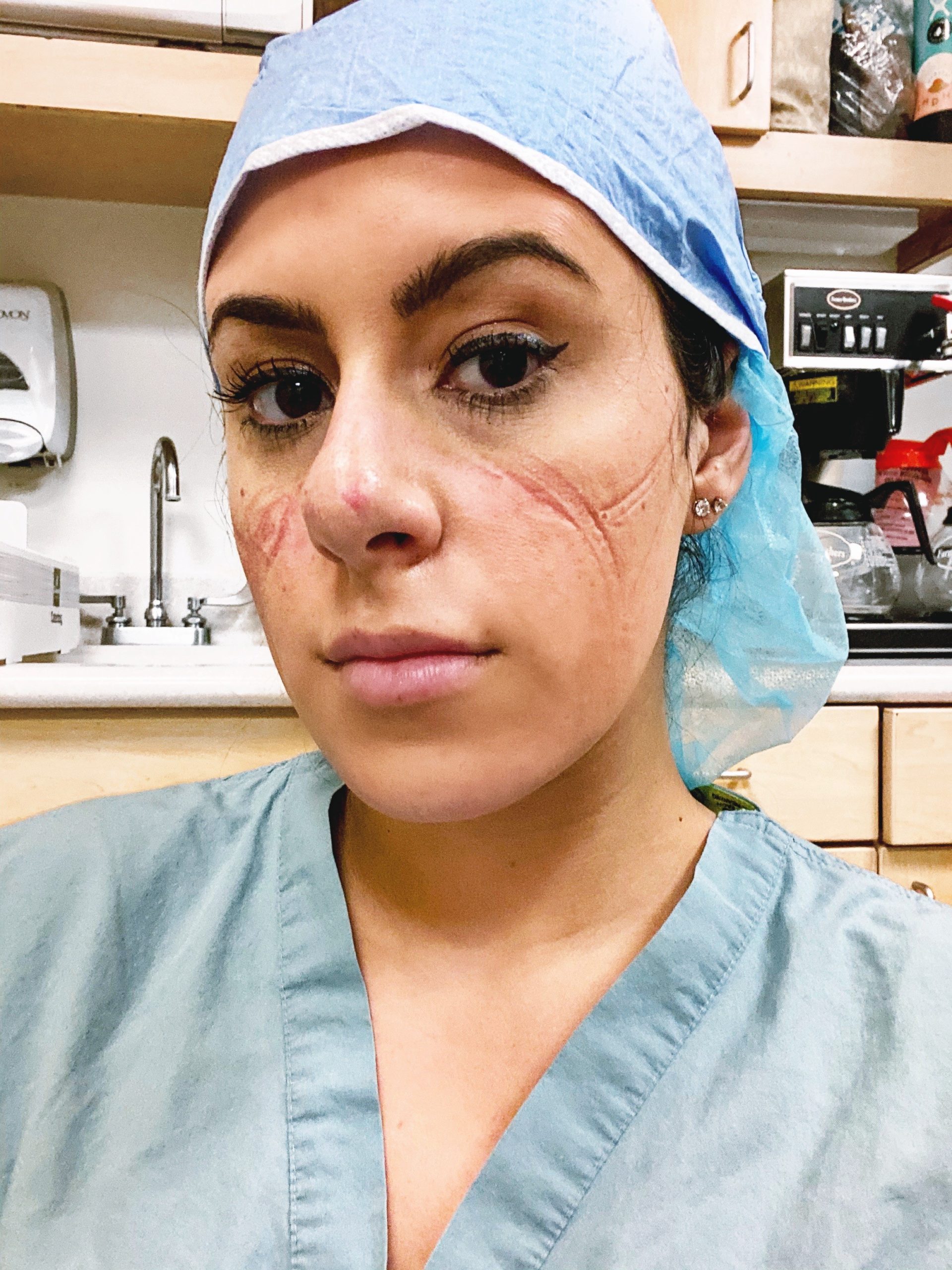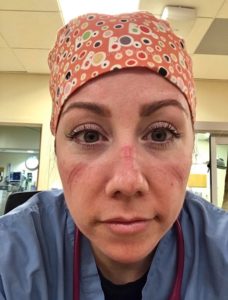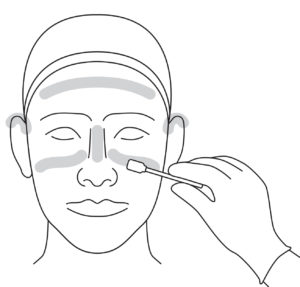
(Marissa shows her skin damage from extended use of PPE)
You’ve seen their faces. You’ve seen the exhaustion and the stress. You’ve seen the temporary surface grooves and bruising on their skin – breakdown that can be associated with the required extended use of the very equipment that helps protect healthcare workers from exposure to certain particulates and the spread of COVID-19.
Many clinicians on the front lines of the crisis are wearing personal protective equipment (PPE) for long hours without a break. With this prolonged use, breakdown of skin can occur.
Heather, an emergency room nurse in New Jersey, goes into work and dons a gown, gloves, hair covering, eye protection, an N95 respirator and a surgical mask*. “You just keep going until you need a break,” she says. “Sometimes I wear PPE for six hours straight during a 12-hour shift.”
Wearing the respirator and goggles for extended periods has contributed to temporary bruising and breakdown of her skin. It eventually fades, but she knows it is part of helping to stay safe.
While some healthcare workers have worn N95 respirators and goggles to treat patients with tuberculosis, or even Ebola, the prolonged use of PPE now is unlike anything they’ve experienced.
“I was active during the Ebola threat, and we were taught how to don and doff N95 respirators,” says Dr. Colleen Foster, an emergency medicine physician in Colorado.
She adds that comfort is relative. “It is more comfortable to wear a respirator than to be concerned about level of risk.” Colleen says that she’s had some transient skin breakdown and there were times when she had her mask on too tight and got a bruise on her nose.
Marissa, who normally works in the cardiac intensive care unit (ICU) in Arizona, has also experienced the challenges that extended use of PPE can have on skin. “It puts pressure on the same places on your face over and over,” Marissa says. “Some nurses have talked about using foam pads, but the hospital told us that may impact the seal of the respirator, which we cannot risk.”
Our commitment to skin
“3M has pioneered the creation of formulations for both intact and damaged skin that protect against friction, shear and further tissue trauma,” said Dr. Matthew Cooper, 3M’s global senior medical director and director, Health Care Clinical Operations. “The long-term use of PPE can in certain circumstances create a situation of repetitive skin trauma. 3M’s products are ideally suited to help protect the skin from initial damage, protect from further damage, and facilitate healing when such protective equipment must still be worn.”
3M products that can help protect the sensitive skin on faces — while not being expected to interfere with the fit of 3M filtering facepiece respirators — include 3M™ Cavilon™ No Sting Barrier Film and 3M™ Cavilon™ Advanced Skin Protectant.
On the front lines

For Heather, dedication to her patients overrides any concerns she has for herself. Even though she has three kids depending on her, she volunteers to work in the adult emergency room instead of the pediatric emergency room where she normally works.
And even with how extended wear of PPE can affect her skin, she said she’s going to see this fight through.
“I want to at the end of this feel like I did enough,” she said.
Tips for your skin
- Protect your skin from friction and moisture, that can be associated with extended use of PPE
- Apply a liquid barrier film or skin protectant.
- Cushion skin, or cover an abrasion, under PPE that does not require a seal to skin.
- Reduce pressure on your skin
- Ensure proper fit.
- Don’t overtighten the respirator.

- Confirm proper positioning of headbands.
- Avoid wearing a mask over the respirator. An increase in tightness can occur.
- If possible, remove the respirator at regular intervals, in non-contaminated areas.
- Prevent interference with the seal
- Do not use thick creams, ointments, petroleum jelly, polyurethane foams or hydrocolloids and other products that could interfere with the fit and seal of PPE.
- If using a dressing, select the lowest profile dressing available. Conduct a fit test, as well as perform a user seal check each time a respirator is worn.
For a complete set of tips and product recommendations, visit 3M.com/PPEskin.
Note, certain products may not be appropriate due to their potential to interfere with the fit/functionality of PPE. Users of PPE should always follow the product User Instructions, including completion of a user seal check each time a respirator is put on.
*Wearing a covering such as a surgical mask over the respirator is not recommended and may impact the respirator’s performance. To provide fluid resistance while wearing standard filtering facepiece respirators, CDC recommends wearing a faceshield over the respirator.
